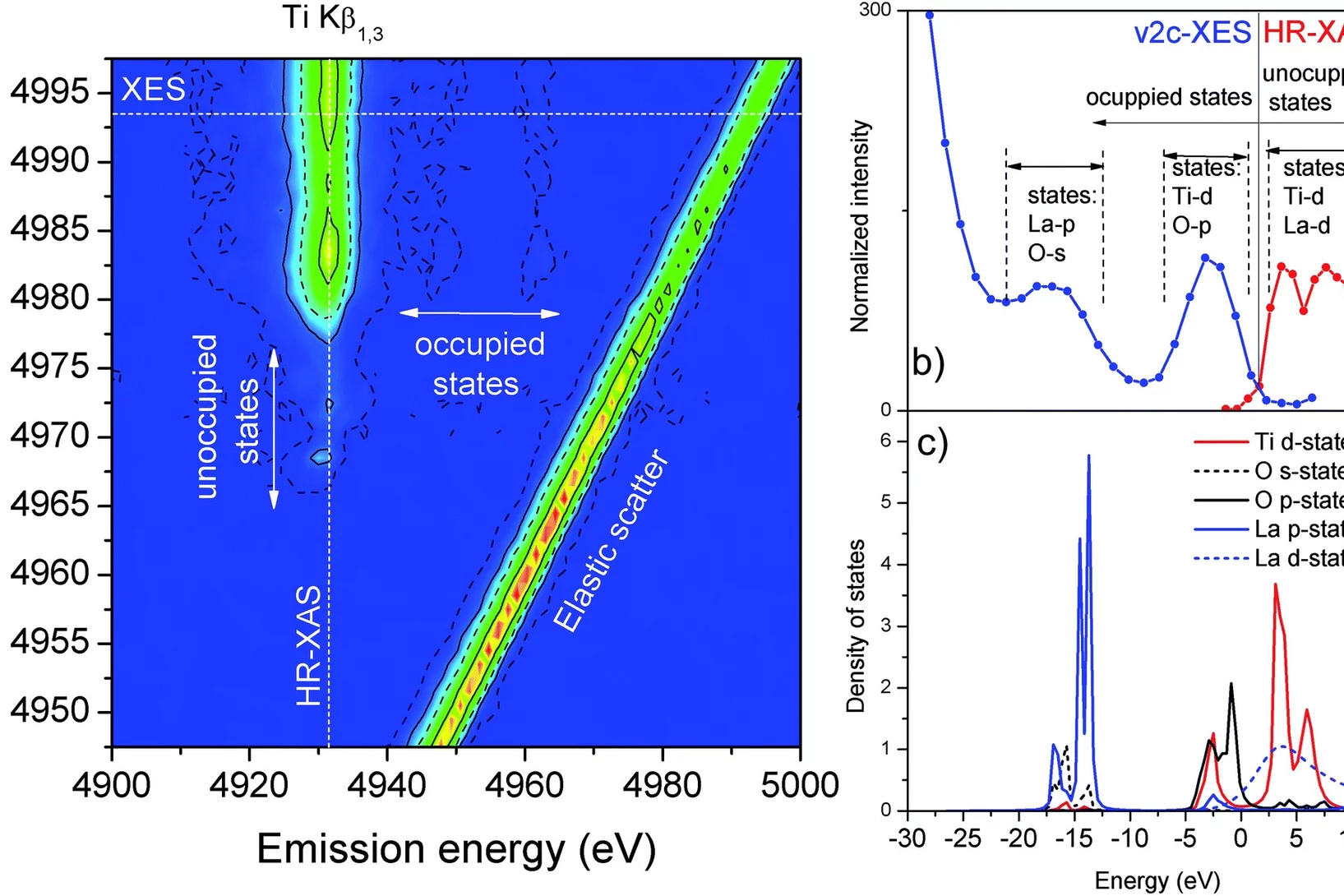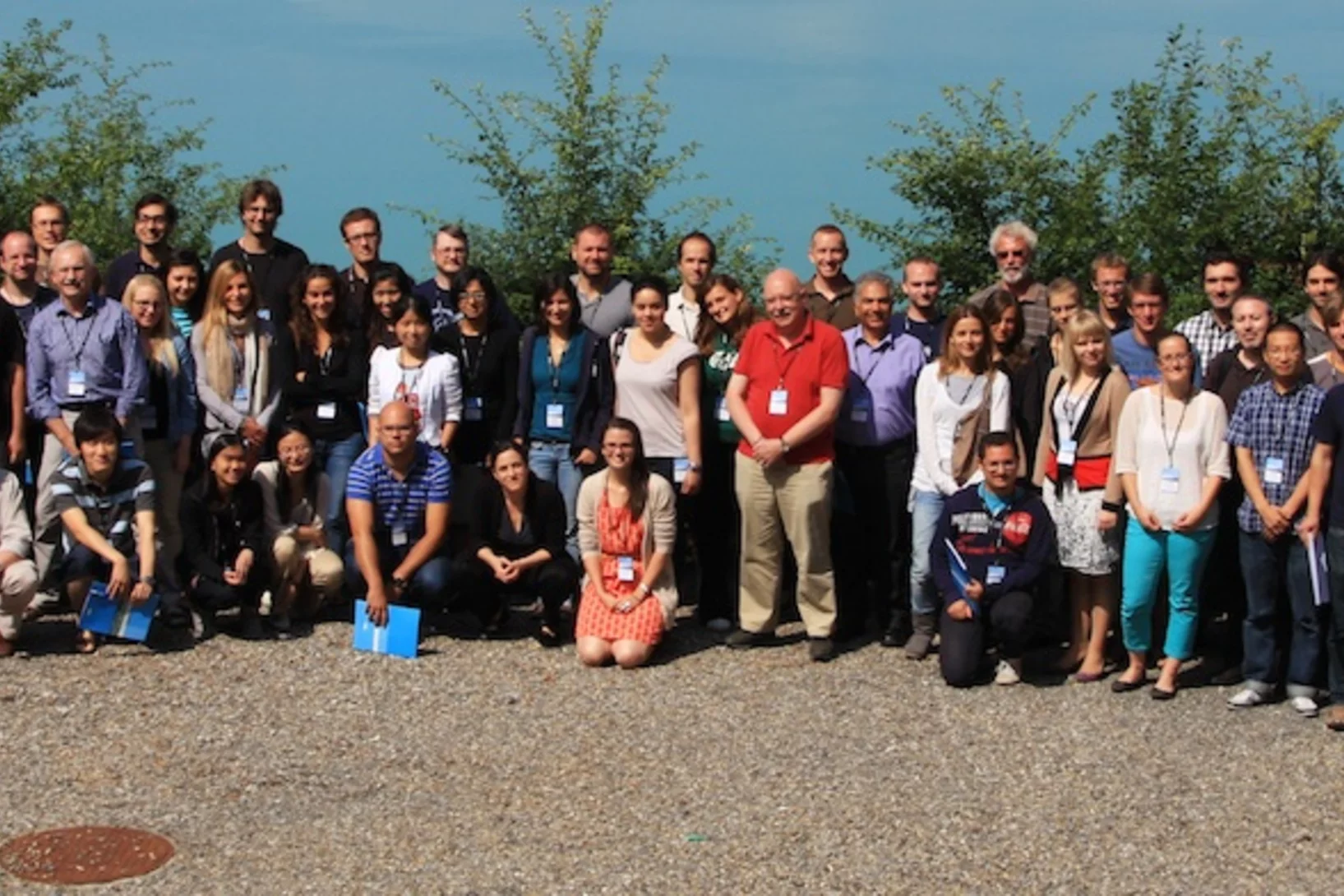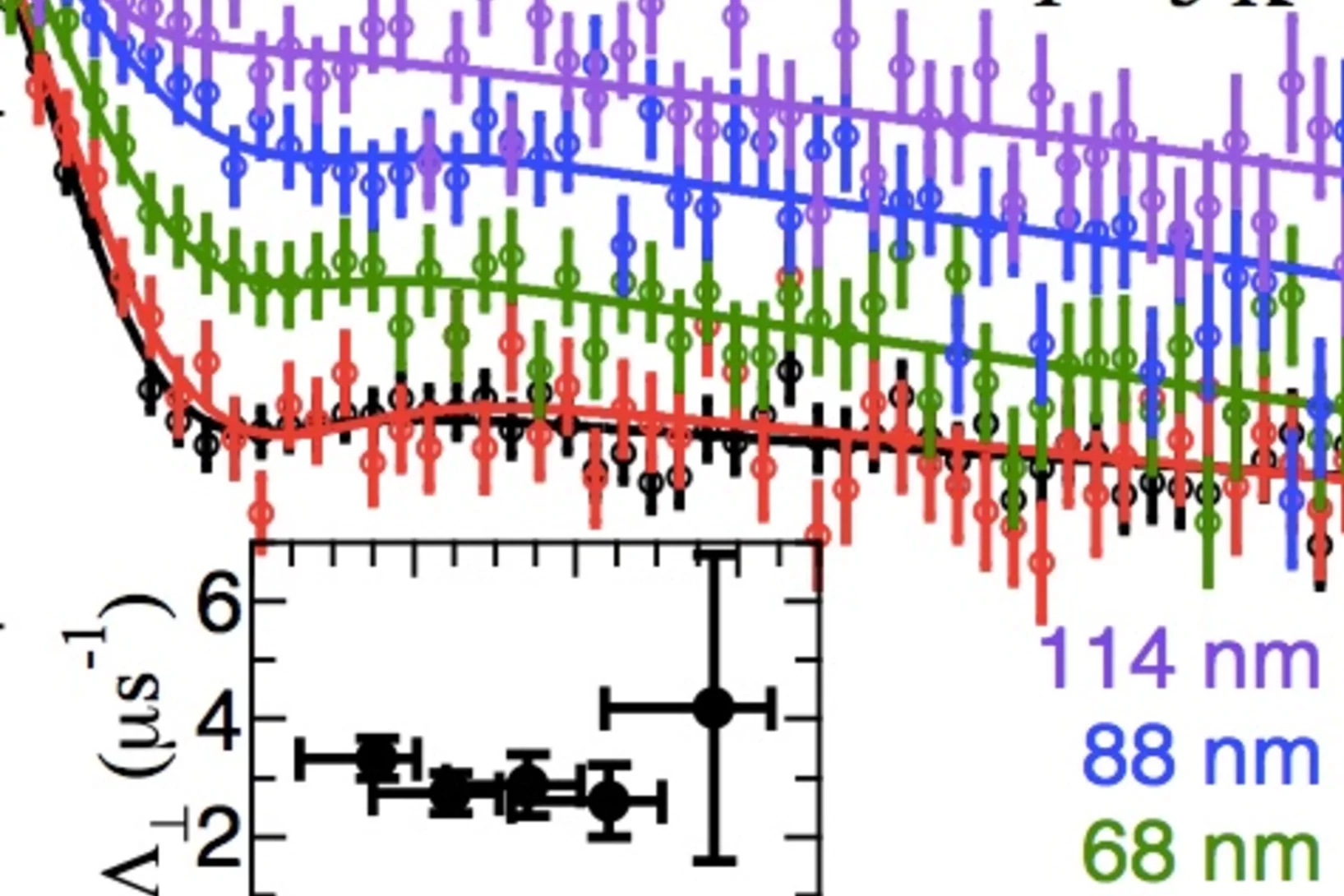Au PSI, plusieurs projets se consacrent à des questions de recherche importantes autour du coronavirus Sars-CoV-2 et des maladies qui en résultent. Nous vous informons sur les activités et les projets, par exemple sur les analyses de tissus pulmonaires, sur la production de protéines et d'anticorps ou sur les idées de nouvelles recherches sur le Covid-19.
Liens utils
Nouvelle table interactive sur le SwissFEL
Le SwissFEL sera mis en service à l’Institut Paul Scherrer PSI en 2016. Au centre pour les visiteurs psi forum, il est possible d’explorer aujourd’hui déjà le nouveau grand instrument de recherche du PSI : une table interactive suivra l’évolution du SwissFEL, de sa construction à son exploitation régulière, en passant par sa mise en service.
Bipartite magnetic parent phases in the iron oxypnictide superconductor
High-temperature superconductivity appears as a consequence of doping charge carriers into an undoped parent compound exhibiting antiferromagnetic order; therefore, ground-state properties of the parent compound are highly relevant to the superconducting state. On the basis of this logic, spin fluctuations have been considered as the origin of pairing of the superconducting electrons in the cuprates.
Direct Observation of Magnetic Metastability in Individual Iron Nanoparticles
Studying the magnetization of individual iron (Fe) nanoparticles by magnetic spectromicroscopy reveals that superparamagnetic (SPM) and ferromagnetic blocked (FM) nanoparticles can coexist in the investigated size range of 8-20 nm.
Calculer l’empreinte écologique
Cela fait 10 ans que l’Institut Paul Scherrer exploite ecoinvent, en partenariat avec l’EPF Zurich, l’EPF Lausanne, l’Empa et Agroscope. En matière de bilans écologiques, cette banque de données est mondialement à la pointe. La troisième version d’ecoinvent, la plus récente, réunit à présent de nouvelles données dans des domaines comme la production d’électricité, l’agriculture, le traffic, l’industrie minière et les produits chimiques. Pour le secteur de l’électricité, qui revêt une grande importance dans les analyses de cycle de vie, la banque de données inclut désormais plus de 80% de la production globale. Et certaines technologies y ont désormais leur place, comme la géothermie profonde, qui n’avaient pas été prises en compte jusqu’ici. Résultat : des évaluations écologiques plus précises des produits et des services
Observation en direct avec un laser à rayons X : l’électricité contrôle la magnétisation
Des chercheurs de l’EPF Zurich et du PSI montrent qu’il est possible de modifier la structure magnétique très rapidement dans certains matériaux novateurs. L’effet pourrait trouver une application dans de futurs disques durs performants.
Comprehensive study of the spin-charge interplay in antiferromagnetic La2-xSrxCuO4
The origin of the pseudogap and its relationship with superconductivity in the cuprates remains vague. In particular, the interplay between the pseudogap and magnetism is mysterious. Recent low-temperature angle-resolved photoemission spectroscopy (ARPES) experiments on the underdoped cuprate superconductors indicate the presence of a fully gapped Fermi surface (FS); even in the antiferromagnetic phase.
Pressure-Induced Quantum Critical and Multicritical Points in a Frustrated Spin Liquid
The quantum spin-liquid compound (C4H12N2)Cu2Cl6 is studied by muon spin relaxation under hydrostatic pressures up to 23.6 kbar. At low temperatures, pressure-induced incommensurate magnetic order is detected beyond a quantum critical point at Pc ∼ 4.3 kbar. An additional phase transition to a different ordered phase is observed at P1 ∼ 13.4 kbar. The data indicate that the high-pressure phase may be a commensurate one. The established (P-T) phase diagram reveals the corresponding pressure-induced multicritical point at P1, T1 = 2.0 K.
L'accélérateur de protons du PSI : 40 ans de recherche de pointe
Teaser: Recherche sur les matériaux, physique des particules, biologie moléculaire, archéologie : depuis 40 ans, le grand accélérateur de protons de l’Institut Paul Scherrer (PSI) rend possible de la recherche de pointe dans différents domaines.
L’énergie solaire concentrée pour du zinc recyclé plus pur
Des chercheurs de l’Institut Paul Scherrer (PSI) ont fait la démonstration à l’échelle du laboratoire d’un processus thermique solaire de production d’oxyde de zinc (un composé important pour la technologie), à partir de produits recyclés du zinc. Le degré de pureté du produit solaire dépasse celui que permet d’obtenir la voie industrielle établie
Strong Meissner screening change in superconducting radio frequency cavities due to mild baking
We investigate 'hot' regions with anomalous high field dissipation in bulk niobium superconducting radio frequency cavities for particle accelerators by using low energy muon spin rotation (LE-μSR) on corresponding cavity cutouts. We demonstrate that superconducting properties at the hot region are well described by the non-local Pippard/BCS model for niobium in the clean limit with a London penetration depth λL=23+/-2 nm . In contrast, a cutout sample from the 120C baked cavity shows a much larger λ>100nm and a depth dependent mean free path, likely due to gradient in vacancy concentration. We suggest that these vacancies can efficiently trap hydrogen and hence prevent the formation of hydrides responsible for rf losses in hot regions.
Ice-core based assessment of historical anthropogenic heavy metal (Cd, Cu, Sb, Zn) emissions in the Soviet Union
The development of strategies and policies aiming at the reduction of environmental exposure to air pollution requires the assessment of historical emissions. Although anthropogenic emissions from the extended territory of the Soviet Union (SU) considerably influenced concentrations of heavy metals in the Northern Hemisphere, Pb is the only metal with long-term historical emission estimates for this region available, whereas for selected other metals only single values exist.
L'art de l'ingénierie, sur mesure
Pour que les électrons du SwissFEL ne se fourvoient pasCoûts réduits et taux d’erreurs minimal : dans le développement des alimentations de puissance pour les aimants du SwissFEL, les ingénieurs du PSI de la Section Electronique de puissance se sont fixé des objectifs ambitieux.
Determination of conduction and valence band electronic structure of La2Ti2O7 thin film
The electronic structure of a La2Ti2O7-layered perovskite thin film was determined by resonant inelastic X-ray scattering (RIXS) measurements and FEFF calculations. It was found that the empty Ti and La d-band states dominate the conduction band of the structure, whereas the top edge of the valence band is mainly composed of filled O-p states. Furthermore, there is a pronounced overlap between occupied La-p states and O-s states, which are located deeper in the valence band.
Eveiller la curiosité naturelle
Entretien avec Beat Henrich.Beat Henrich est physicien et dirige le laboratoire pour écoliers iLab, à l’Institut Paul Scherrer. Dans cet entretien, il explique comment il s’y prend pour enthousiasmer les jeunes pour la physique.
La physique sur réseau : mieux comprendre les gaz confinés
La méthode Boltzmann sur réseau a vu le jour au début des années 1990. Objectif de cette méthode de calcul : résoudre l’équation de Boltzmann de manière numérique, c’est-à-dire à l’aide d’ordinateurs. Avec leur nouveau modèle, des chercheurs de l’Institut Paul Scherrer élargissent à présent le domaine d’application de la méthode de Boltzmann sur réseau à des situations plus complexes. Avec leur travail, les scientifiques du PSI ouvrent la voie à des simulations informatiques plus réalistes de nombreux processus techniques complexes, par exemple dans les structures microporeuses de catalyseurs techniques, dans les filtres à particules diesel, les microréacteurs à combustion, ou encore dans les piles à combustible.
X-ray tomography reaches 16 nm isotropic 3D resolution
Researchers at PSI reported a demonstration of X-ray tomography with an unmatched isotropic 3D resolution of 16 nm in Scientific Reports. The measurement was performed at the cSAXS beamline at the Swiss Light Source using a prototype instrument of the OMNY (tOMography Nano crYo) project. Whereas this prototype measures at room temperature and atmospheric pressure, the OMNY system, to be commissioned later this year, will provide a cryogenic sample environment in ultra-high vacuum without compromising imaging capabilities. The researchers believe that such a combination of advanced imaging with state-of-the-art instrumentation is a promising path to fill the resolution gap between electron microscopy and X-ray imaging, also in case of radiation-sensitive materials such as polymer structures and biological systems.
PSI summer school 2014
The PSI summer school 2014 on Condensed Matter Research will be organized at the Institut Montana in Zug, Switzerland from August 9-15, 2014. The topic of the school will be 'Exploring time, energy and length scales in condensed matter' and the school will be followed by hands-on practical training at the PSI large user facilities SINQ, SμS and SLS. Online registration and detailed information is available from the school's webpage.
Unique insight into carbon fibers on the nanoscale
Novel carbon materials are promising candidates for light and robust low-cost materials of the future. Understanding their mechanical properties benefits from highly resolved three-dimensional (3D) maps of their porosity and density fluctuations in uninterrupted representative volumes, but these are difficult to obtain with conventional imaging methods.
Frustration-induced nanometre-scale inhomogeneity in a triangular antiferromagnet
Phase inhomogeneity of otherwise chemically homogenous electronic systems is an essential ingredient leading to fascinating functional properties, such as high-Tc superconductivity in cuprates, colossal magnetoresistance in manganites and giant electrostriction in relaxors. In these materials distinct phases compete and can coexist owing to intertwined ordered parameters. Charge degrees of freedom play a fundamental role, although phase-separated ground states have been envisioned theoretically also for pure spin systems with geometrical frustration that serves as a source of phase competition.
High-tech jusqu’au toit
Dans la forêt de Würenlingen, les travaux de constructions avancent à grands pas : le bâtiment du SwissFEL, le nouveau grand instrument de recherche de l’Institut Paul Scherrer, doit être achevé d’ici fin 2014. Les exigences à satisfaire par la construction sont élevées. Le bâtiment doit assurer une exploitation sans heurt de cette installation hautement sensible.
X-ray tomography reaches 16 nm isotropic 3D resolution
Tomographic microscopy has become an invaluable imaging method in both life and materials sciences. Oftentimes, high resolving power is required simultaneously with the ability to characterize large, statistically representative sample volumes. To this task, researchers at the Paul Scherrer Institut have established ptychographic computed tomography.
Spintronics: deciphering a material for future electronics
Topological insulators are the key to future spintronics technologies. EPFL scientists have unraveled how these strange materials work, overcoming one of the biggest obstacles on the way to next-generation applications.Read the full story
Mesures des aérosols dans le monde : des chercheurs du PSI contribuent à combler les lacunes
Les aérosols sont des particules de poussière fine en suspension dans l’atmosphère. Ils sont susceptibles d’influencer le climat : par absorption directe ou par diffusion du rayonnement solaire, ou encore en tant que germes de condensation pour la formation des nuages. Les climatologues s’efforcent de quantifier ces effets de manière exacte, et d’améliorer ainsi les modèles climatiques. Mais leur tâche est compliquée par le fait qu’il n’existe pas de réseau complet de stations de mesure d’aérosols, déployé sur l’ensemble du globe. Des chercheurs de l’Institut Paul Scherrer s’engagent pour permettre des mesures des aérosols en continu, là où les lacunes sont les plus importantes.
Dépôts en couches géologiques profondes : les pores de la roche se referment
On sait d’ores et déjà que certaines réactions chimiques modifieront les caractéristiques du dépôt en couches géologiques profondes, de même que celles de la roche environnante (roche argileuse). Mais dans quelle mesure, et avec quelles conséquences pour la sécurité ? Des chercheurs de l’Institut Paul Scherrer tentent de répondre à cette question, en combinant expériences et simulations informatiques.
Switching of magnetic domains reveals spatially inhomogeneous superconductivity
The interplay of magnetic and charge fluctuations can lead to quantum phases with exceptional electronic properties. A case in point is magnetically-driven superconductivity, where magnetic correlations fundamentally affect the underlying symmetry and generate new physical properties. The superconducting wavefunction in most known magnetic superconductors does not break translational symmetry.
Magnetoelastic Excitations in the Pyrochlore Spin Liquid Tb2Ti2O7
Tb2Ti2O7 is often referred to as a spin liquid as it does indeed remain in a magnetically disordered phase with spin dynamics down to 0.05 K, but this itself is a surprise since there are strong expectations of magnetic order and/or a structural distortion. However, throughout the spin liquid regime there are also strong signs of magnetoelastic coupling, leading to the suggestion that both spin and structural degrees of freedom are frustrated.
Supervolcano eruptions driven by melt buoyancy in large silicic magma chambers
Super-eruptions that dwarf all historical volcanic episodes in erupted volume and environmental impact are abundant in the geological record. Such eruptions of silica-rich magmas form large calderas. The mechanisms that trigger these supereruptions are elusive because the processes occurring in conventional volcanic systems cannot simply be scaled up to the much larger magma chambers beneath super volcanoes.
Reaction Conditions of Methane-to-Methanol Conversion Affect the Structure of Active Copper Sites
Determining the structure of the active Cu sites, which are associated with the methane conversion intermediate during stepwise, low-temperature, methane-to-methanol conversion, represents an important step for the upgrade of this reaction route to a viable process. Quick X-ray absorption spectroscopy allowed us to follow the electronic and structural changes to the active Cu sites during reaction with methane and during desorption of the activated intermediate. A large fraction (41%) of the oxygen-activated CuII reacted with methane and underwent reduction to CuI.
Bulk superconductivity in undoped T'-La1.9Y0.1CuO4 probed by muon spin rotation
The Meissner effect has been directly demonstrated by depth-resolved muon spin rotation measurements in high-quality thin films of the T'-structured cup rate, T'-La1.9Y0.1CuO4, to confirm bulk superconductivity (Tc ≈ 21 K) in its undoped state. The gradual expelling of an external magnetic field is observed over a depth range of ∼ 100 nm in films with a thickness of 275(15) nm, from which the penetration depth is deduced to be 466(22) nm. Based on this result, we argue that the true ground state of the “parent” compound of the n-type cuprates is not a Mott insulator but a strongly correlated metal with colossal sensitivity to apical oxygen impurities.
Supraconductivité activée par un champ magnétique
Le plus souvent, on considère supraconductivité et champs magnétiques comme étant des concurrents : en effet, de façon générale, les champs magnétiques intenses brisent l’état supraconducteur. Des physiciens de l’Institut Paul Scherrer (PSI) ont montré récemment que dans le matériau CeCoIn5, un nouveau type d’état supraconducteur apparaissait en présence de forts champs magnétiques externes, et que ce nouvel état supraconducteur pouvait ensuite être manipulé en jouant avec ces champs. Ce matériau est déjà un supraconducteur à faible champ. Mais en présence de champs intenses, un second état supraconducteur différent apparaît.






























